Abstract
Wood-cement panels are becoming increasingly widely used as prefabricated building materials. In order to increase the use of renewable resources as materials for industrial applications, the use of alternative plant fibres has been gaining interest. Additionally, it is assumed that new or better board properties can be achieved due to the different chemical and mechanical properties of such alternative sources of fibres. In south-eastern Spain, the Canary Islands palm (Phoenix canariensis) is widely used in urban landscaping. Plantations attacked by red palm weevils generate abundant plant waste that must be shredded and taken to authorised landfills. This paper discusses the use of particles of Canary Islands palm for manufacturing fibre panels containing 20% cement in relation to the weight of the particles, using different proportions of starch as a plasticiser. A pressure of 2.6 MPa and a temperature of 100 °C were used in their production. Density, thickness swelling, water absorption, internal bonding strength, modulus of rupture (MOR), modulus of elasticity (MOE), and thermal conductivity were studied. The mechanical tests showed that the MOR and MOE values increased with longer setting times, meaning that the palm particles were able to tolerate the alkalinity of the cement. The board with 5% starch had a MOR of 15.76 N·mm−2 and a MOE of 1.872 N·mm−2 after 28 days. The boards with thicknesses of 6.7 mm had a mean thermal conductivity of 0.054 W·m−1·K−1. These boards achieved good mechanical properties and could be used for general use and as a thermal insulation material in building construction.
1. Introduction
Wood-cement boards for formwork, roofing, sandwich panels, wall coverings, partition walls, prefabricated houses, false ceilings, and flooring are becoming increasingly widely used in building construction. These are boards made of wood particles or cellulose fibres mixed with cement, water, and chemical additives.
Given the shortage of wood, the latest trends are aimed at using other plant fibres. Around the world, a large amount of plant waste is generated from various sources; thus, using this waste would contribute to its recycling and reutilisation.
The Canary Islands palm is a species of the family Arecaceae or Palmae, of the genus Phoenix, which it is endemic to the Canary Islands (Spain). It forms a natural hybrid with the date palm (Phoenix dactilifera L.), meaning that there are many hybrid cultivars that are difficult to distinguish from one another. The Canary Islands palm is more vigorous than the date palm, and its stipe reaches a height of 20 m and a diameter of 40 to 50 cm.
The red palm weevil (Rhynchophorus ferrugineus O.) invaded the states of the Persian Gulf in the mid-1980s, causing serious damage to palm trees [1]. The nature of the plant, together with the transport of seed material, has added to the rapid development and spread of this pest over a short period of approximately a decade, and it now affects more than 60 countries in Europe, Africa, and the Middle East. The pest usually leads to death of the palm tree unless appropriate curative measures are taken. However, it is often not possible to take curative measures at the start of the attack, as it is difficult to detect at an early stage of infestation [2]. As in most Mediterranean countries, palm trees are widely used in urban landscaping in south-eastern Spain, and the Canary Islands palm (Phoenix canariensis) is one of the most abundant species in the area. Consequently, the numerous plantations affected by red palm weevil damage generate a large amount of plant waste that must be shredded and transferred to an authorised landfill. Using this waste is one way to help adopt sustainable solutions for the control and eradication of contaminated specimens while also producing benefits for the environment.
Different plant fibres have been tested with cements and cement mortars: sisal fibres, bamboo, coconut shell and natural jute [3], hemp fibres [4], sisal and banana fibres [5], date palm rachis fibres [6], Arundo donax L. [7], jute fibres [8,9], and waste jute fibres from the textile industry [10]. Some studies [11] concluded that in general, plant fibres suffer degradation problems with cement. Therefore, different methods have been proposed to modify plant fibres in order to prevent their degradation: alkaline treatment of jute fibres [12], silane treatment of sugar cane bagasse fibres [13], modification of kenaf fibres by various chemical treatments [14], and treatment of date palm rachis fibres in three alkaline solutions [7].
In tests conducted on plant fibre composites with cement [6], it was reported that they suffered a severe decrease in the modulus of rupture and modulus of elasticity after one year’s exposure to temperate or tropical environments, concluding that these reductions could be attributed to the carbonation of the matrix followed by leaching and progressive microfisuration. Degradation has also been shown to be due to the carbonation of plant fibres [15].
In a review of research on the use of plant fibres in cement composite materials [16], it was deduced that cellulosic elements present great variability in their mechanical properties because their degradation is mainly due to alkaline degradation and fibre mineralisation. These mechanisms bring about changes in the chemical composition of the fibres, which in turn causes a reduction in strength and degradation of the polymer matrix and of the fibre/polymer matrix interfacial bond.
In general, the literature indicates that in composite materials made from cement reinforced with plant fibres, there was a decrease in the heat of hydration [13,17,18], which is attributed to different components of the plant fibres. Consequently, Vo and Navard [19] stated that selecting sources of biomass with a low content of these compounds would minimise these drawbacks.
A study of cement composites reinforced with natural fibres [20] showed that cement hydration would initially be improved by increasing the curing temperature, adding chemical accelerators, and using materials with a high surface area.
The addition of starch to cement has also been investigated. It has been suggested that a mixture of polysaccharides such as cellulose and starch was a good water retention agent [21]. These additives are also set retarding agents that improve the working time and modify cement hydration. Zhang et al. [22] conducted a study on the dispersion mechanism of sulphonated starch as a water-reducing agent for cement. Ferrández-García et al. [23] studied cement boards with different proportions of starch, concluding that their mechanical properties were suitable for use in load-bearing structures.
The Canary Islands palm trunk has been studied as a material for manufacturing particleboards, and it was shown that using 20% starch as an adhesive and a pressing time of 30 minutes in the hotplate press, the boards could be classified as Grade P2 [24] and used for manufacturing furniture, flooring, and false ceilings [25].
The objective of this study was to evaluate a new composite made from Canary Islands palm trunk biomass agglomerated with cement and starch, to analyse the physical, mechanical, and thermal properties of these panels and to determine whether the palm particles degrade over time. Since these boards are considered products of high environmental value and long duration, the manufacture of such boards could help to decrease the atmospheric concentration of CO2 by fixing it and thus providing benefits for the environment.
2. Materials and Methods
2.1. Materials
The materials used were type CEM II/B-LL 32.5 N Portland cement, water, particles of Canary Islands palm trunk (Figure 1), and different proportions of potato (Solanum tuberosum L.) starch.
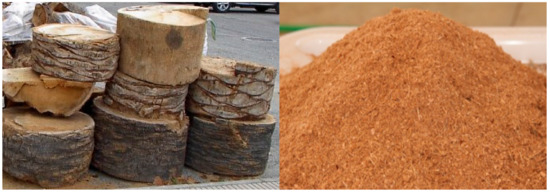
Figure 1.
Palm trunks infested with red palm weevil and palm particles.
The Canary Islands palm biomass was obtained from palm trees infested with red palm weevil at the Higher Technical College of Orihuela at Universidad Miguel Hernández, Elche. The palm trunks were cut before being chopped and left to dry outdoors for 6 months. They were then shredded in a blade mill, and a vibrator sieve was used to select a particle size between 0.25 and 1 mm (Figure 1). The particles had a relative humidity of 54% and were left to air dry for an additional 3 months until a relative humidity of 10% was reached.
Potato starch from the food industry was used as a plasticiser, with a purity of 90%. Chemically, starch is a mixture of two very similar polysaccharides, namely amylose and amylopectin. Potato starch typically contains large oval-shaped granules and has a gelatinisation temperature of 58–65 °C. The water was taken directly from the mains drinking water network, with an average temperature of 20 °C.
2.2. Manufacturing Process
The manufacturing process involved dry mixing the cement and palm particles with different proportions of starch (0%, 5%, and 10%). Subsequently, 10% water was sprayed onto the mixture, which was stirred for 10 minutes in a blender (LGB100, Imal, S.R.L., Modena, Italy) to homogenise it at 30 rpm.
The mat was formed in a mould of dimensions 600 mm × 400 mm and was subjected to pressure and heat in a hotplate press, applying a pressure of 2.6 MPa and a temperature of 100 °C for 2 or 3 h. The boards were then removed from the press and stacked horizontally at room temperature for the first 3 days of setting, before being positioned vertically and kept under ambient conditions in the laboratory. The approximate dimensions of the boards were 600 mm × 400 mm × 6.7 mm. Six types of board were manufactured, with different compositions and pressing times. The characteristics of each type of particleboard are shown in Table 1.

Table 1.
Characteristics and composition in weight of the manufactured panels.
Eight days after they were prepared, the samples were cut to perform the tests required to determine the mechanical, physical, and thermal properties of each of the six types of board that were studied (Figure 2). Ten particleboards were manufactured for each type. The samples were kept for 24 h in a refrigerated cabinet (model Medilow-L, JP Selecta, Barcelona, Spain) at a temperature of 20 °C and relative humidity of 65% before performing the tests.
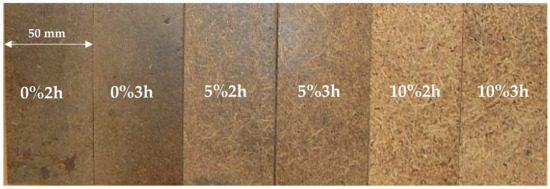
Figure 2.
Types of boards manufactured.
2.3. Methods
The morphology of the inside of the Canary Islands palm trunk was examined using a scanning electron microscope (SEM) (Hitachi model S3000N, Hitachi, Ltd., Tokyo, Japan) equipped with an X-ray detector (Bruker XFlash 3001, Billerica, MA, USA). Images were taken of fractured 5 mm × 5 mm cross-sections.
The method followed was experimental, conducting tests in the Materials Strength Laboratory of the Higher Technical College of Orihuela at Universidad Miguel Hernández, Elche. The values were determined according to the European standards established for wood particleboards [26].
Density [27], moisture content [28], thickness swelling and water absorption after 2 and 24 h immersed in water [29], internal bonding strength [30], and thermal conductivity and resistance [31] were measured 28 days after they were manufactured. The moisture content was measured with a laboratory moisture meter (model UM2000, Imal S.R.L, Modena, Italy). The water immersion test was carried out in a heated tank. The thermal conductivity and resistance tests were conducted with a heat flow meter (NETZSCH Instruments Inc., Burlington, MA, USA). A sample of each board of dimensions 300 mm × 300 mm × 6.7 mm was used for this test.
To assess the possible degradation of Canary Islands palm particles in contact with cement, the modulus of rupture (MOR) and the modulus of elasticity (MOE) were evaluated 8, 28, and 90 days after the boards were manufactured [32]. This test was performed on two samples of each board.
The mechanical tests were performed with the universal testing machine (model IB700, Imal, S.R.L., Modena, Italy), which complies with the velocity of 5 mm·min−1 for the bending test and 2 mm·min−1 for internal bonding strength, as specified by the applicable European standards [30,32].
The standard deviation was obtained for the mean values of the tests, and analysis of variance (ANOVA) was performed for a significance level of α < 0.05. The statistical analyses were performed using SPSS v. 26.0 software (IBM, Chicago, IL, USA).
3. Results and Discussion
3.1. SEM Observations
The image of the longitudinal section of the Canary Islands palm trunk is shown in Figure 3, where it is possible to observe the typical features of the vascular bundles (fibres, vessels, and phloem embedded in parenchymatous tissue). The vascular bundles are covered by circular silica phytoliths with protruding cones that appear brighter in the SEM image due to their mineral composition. Silica phytoliths are composed of common silicates.
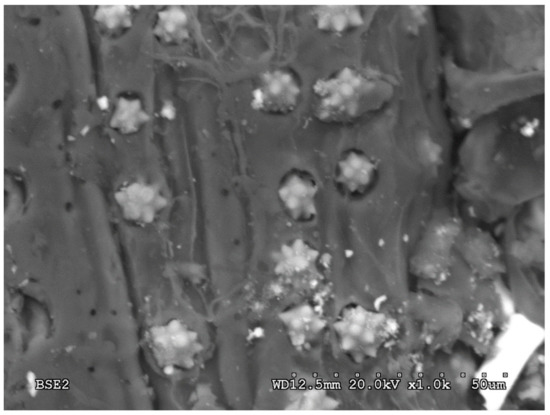
Figure 3.
Micrography of the longitudinal section of Canary Islands palm trunk.
The silicon content may be related to the fact that the particles do not degrade in an alkaline medium [33], but this result was not conclusive in this study.
3.2. Physical Properties
The density and moisture content values are shown in Figure 4. When starch is added, the density of the boards decreases from 1083.652 kg·m−3 in the starch-free boards to 1039.259 kg·m−3 in the boards to which 10% starch is added.
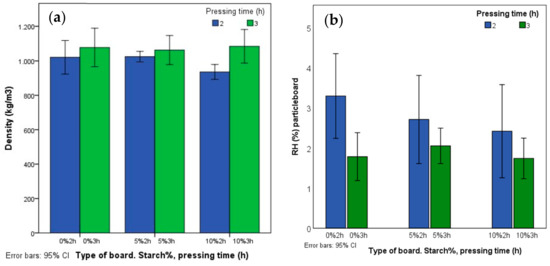
Figure 4.
Mean density (a) and relative humidity (RH) (b) according to type of board.
These can be classified as high-density boards, although the density is lower than that of wood-cement boards. The ANOVA showed that the density depends on the type of board, pressing time, and percentage of starch added.
The relative humidity (RH) of the boards decreases the longer they are kept in the press. The values obtained are between 1.73% and 3.29%, meaning that all the boards tested have a very low RH. According to the ANOVA performed, it can be observed that the RH depends on the type of board and the pressing time.
The results of the thickness swelling test (TS) are shown in Figure 5. In the water immersion test, it can be seen that after 2 h, all three types of board show similar thickness swelling values (14%). After 24 h, the starch-free boards have a mean TS value of 30.2%, those with 5% starch have a mean TS value of 28.8%, and those with 10% starch have a mean TS value of 25.2%.
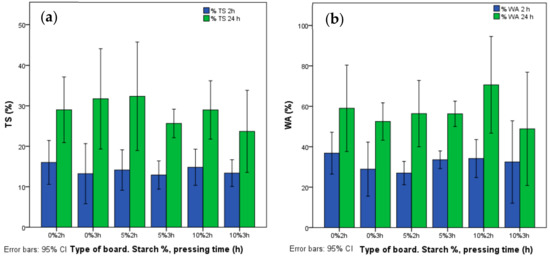
Figure 5.
Percentage of thickness swelling (a) and water absorption (b) after 2 and 24 h.
Thickness swelling over 24 h was greater than that required by the regulations [24] for grade P3 (17%) in all the experimental panels manufactured in this study; therefore, adding a water-repellent substance during the manufacture of the board would improve this parameter.
Although statistically it does not appear to depend on the type of board, pressing time, or starch added, it would be advisable to carry out further tests, subjecting the boards to heat for longer, as is the case with industrial wood-cement boards, which take approximately 8 h to cure applying pressures of 3 and 3.5 MPa at temperatures between 75 and 80 °C.
As shown in Figure 5, the behaviour of the six types of boards is similar in terms of water absorption (WA) after immersion for 2 h (WA ≈ 32%) and 24 h (WA ≈ 56%); there are no significant differences between the six types of board. It can be observed that the standard deviation is higher in the boards with 10% starch. This may indicate that not all of the starch has gelatinised during the manufacture of the boards, meaning that some samples absorbed more water than others in the test.
3.3. Mechanical Properties
The internal bonding strength (IB) values are shown in Figure 6 and are very high. The boards with 10% starch reach mean values of 0.80 N·mm−2, and those without starch reach 0.58 N·mm−2; there is a large deviation. This may be due to competition for water between the cement, particles, and starch. The statistical analysis shows that the IB depends on the type of board, pressing time, and percentage of starch used.
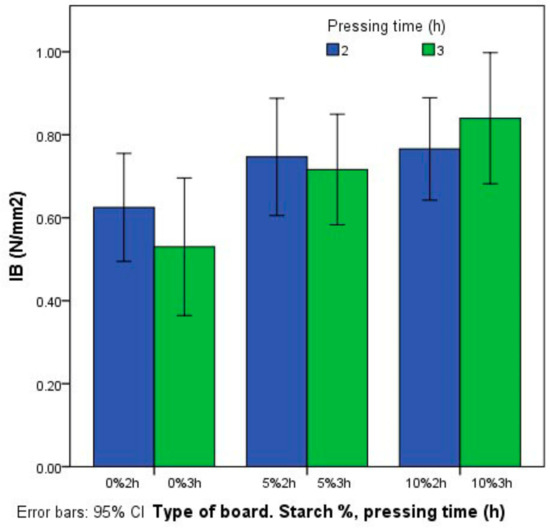
Figure 6.
Internal bonding strength according to type of board.
The results of the bending test after 8, 28, and 90 days are shown in Figure 7. It can be observed that in all the types of board, the modulus of rupture (MOR) and modulus of elasticity (MOE) values increase over time, indicating that the palm biomass tolerates the alkalinity of the cement. The board with 5% starch and 2 h in the press had a MOR of 15.2 N·mm−2 and a MOE of 1,792.6 N·mm−2 after 28 days. In contrast, without starch, the MOR was 13.6 N·mm−2 and the MOE was 1,766.2 N·mm−2. Although the boards with 10% starch have good MOR and MOE values, there is no improvement with respect to the boards with 5% starch. This could be explained by the fact that not all the starch has gelatinised, as there may have been competition for water between the palm particles, cement, and starch. The MOR and MOE values depend on the type of board, time in the hotplate press, and amount of starch added, as can be seen in the ANOVA.
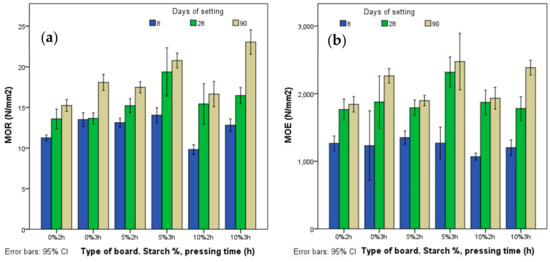
Figure 7.
Modulus of rupture (MOR) (a) and modulus of elasticity (MOE) (b).
The time the boards were in the press influences the properties throughout the setting process. The pressing time was 2 or 3 h, while industrial wood-cement boards remain in the press for 8 h. A longer pressing time appears to result in better mechanical properties, although this will need to be confirmed by further testing involving a production process with a longer pressing time.
All the types of board tested can be classed as Grade P2 particleboards [24], for general use in the manufacture of furniture, interior décor, and enclosures (vertical and horizontal) in dry conditions. In order to achieve better performance and to be classed as load-bearing boards, the TS value needs to be reduced.
One of the major problems for the strength of plant fibre boards with cement is the alkalinity of the matrix, which directly affects the durability of the fibres [34]. This can be seen in several studies where the percentage of cement applied is higher than that used in this work [5,6]. The results obtained show that the modulus of rupture (MOR) and modulus of elasticity (MOE) increase in all cases after 90 days of setting, based on which it can be stated that the fibres used have tolerated the alkalinity of the cement. This could be explained by the low cement content that has been used to manufacture the board, although it would be necessary to carry out further mechanical tests 365 days after its manufacture in order to confirm this tendency.
To reduce the effect of the cement’s alkalinity, research [13] was carried out showing that treating sugar cane bagasse fibres with silane improved the durability of the compound. Similarly, it has been shown that the silicon content of giant reed [7] could have a beneficial effect on the durability of the reed. As shown in Figure 3, the trunk of the Canary Islands palm contains silicon [35], so it is possible that this compound may help to ensure that the particles do not degrade in an alkaline medium such as cement.
It is possible that the gelatinised starch serves to protect the palm particles, preserving them from degradation and assisting in cement hydration, as seen with other plasticisers [9] and polymers [36]. It is also possible that the composition of the Canary Islands palm trunk may offer better resistance to degradation than other plant fibres because, as seen in Figure 7, its bending strength increases over time, which will need to be confirmed by further tests.
3.4. Thermal Properties
Figure 8 shows the thermal conductivity values obtained. There are no differences between the different types of board, which have a mean thermal conductivity of 0.054 W·m−1·K−1.

Figure 8.
Thermal conductivity (a) and resistance (b) according to type of board.
Table 2 shows the thermal conductivity values obtained by other authors with boards manufactured from other organic fibres and for wood particleboards.

Table 2.
Thermal conductivity obtained in different tests with plant fibre boards and wood particleboards.
Canary Islands palm-cement boards have thermal properties that are in line with those obtained with boards manufactured with other species of palm trees, achieving a level of thermal insulation that is interesting for a board that is classed as high-density, which may be explained by the low relative humidity found in the manufactured boards. The greater density achieved in this study can be explained by the addition of cement to the board, as urea-formaldehyde was used as a binder for palm particles in other research [37,38].
Figure 8 shows the values achieved in terms of the thermal resistance of the boards; there were no significant differences between them. The mean thermal resistance was 0.105 m2·K·W−1, which is higher than the theoretical value obtained for wood particleboards (0.067 m2·K·W−1) with a density of 300 kg/m3, assuming a similar thickness to that used in this work (6.7 mm).
The thermal properties of the boards manufactured in this work are better than of commercial wood and wood-cement particleboards. Moreover, a higher energy consumption is used in the manufacture of industrial wood-cement panels than that used for palm-cement-starch panels: in this work, panels are subjected to a pressure of 2.6 MPa and a temperature of 100 °C for 2 or 3 h, whereas conventional wood-cement panels take approximately 8 h to cure at pressures of 3 and 3.5 MPa and temperature between 75 and 80 °C.
4. Conclusions
The results show that Canary Islands palm-cement boards with good mechanical and thermal properties can be obtained with small amounts of cement (by applying heat and pressure).
The modulus of rupture (MOR) and modulus of elasticity (MOE) increase in all cases after 90 days of setting, meaning that the Canary Islands palm particles have not undergone degradation due to the alkalinity of the cement, although further testing is needed to establish the exact cause of this behaviour. Furthermore, with 5% starch as a plasticiser, the mechanical properties (MOR, MOE, and IB), and density increase. The starch does not have a significant influence on the other properties of the board.
All the manufactured boards have adequate properties for general use in the manufacture of furniture, interior décor, and enclosures (vertical and horizontal) in dry environments. In particular, the low thermal conductivities achieved would allow them to be used as a thermal insulation material.
Further research is needed regarding the different proportions of Canary Islands palm particles, cement, water, and starch, and a longer time in the hot plate press to obtain a product with less thickness swelling after immersion in water.
The palm-cement-starch boards have a lower energy consumption than the industrial wood-cement boards that are currently manufactured.
Particles of Canary Islands palm trunk can be used as an alternative for manufacturing particle cement boards. The utilisation of these waste materials to manufacture products with a long useful life, such as particleboards, can be beneficial to the environment, as it is a method of carbon fixation and therefore contributes to reducing CO2 in the atmosphere.
Author Contributions
M.T.F.-G. and C.E.F.-G. devised and designed the experiments; M.F.-V. and T.G.-O. performed the experiments; A.F.-G. and M.T.F.-G. analysed the data; M.F.-V. contributed reagents/materials/analytical tools; M.F.-V. wrote the first draft of the paper. All the authors assisted in writing and improving the paper. All authors have read and agreed to the published version of the manuscript.
Funding
This research was funded thanks to Agreement No. 4/20 between the company Aitana, Actividades de Construcciones y Servicios, S.L. and Universidad Miguel Hernandez, Elche.
Acknowledgments
The authors would like to thank the company Aitana, Actividades de Construcciones y Servicios, S.L. for its support by signing Agreement No. 4/20 with Universidad Miguel Hernández, Elche, on 20 December 2019.
Conflicts of Interest
The authors declare no conflict of interest.
References
- Murphy, S.T.; Briscoe, B.R. The red palm weevil as an alien invasive: Biology and the prospects for biological control as a component of IPM. Biocontrol News Inf. 1999, 20, 35–46. [Google Scholar]
- Ferry, M.; Gomez, S. The red palm weevil in the Mediterranean area. Palms 2002, 46, 172–178. [Google Scholar]
- Sen, T.; Reddy, H.J. Application of sisal, bamboo, coir and jute natural composites in structural upgradation. Int. J. Innov. Manag. Technol. 2011, 2, 186. [Google Scholar]
- Sedan, D.; Pagnoux, C.; Smith, A.; Chotard, T. Mechanical properties of hemp fibre reinforced cement: Influence of the fibre/matrix interaction. J. Eur. Ceram. Soc. 2008, 28, 183–192. [Google Scholar] [CrossRef]
- Savastano, H.; Santos, S.F.; Radonjic, M.; Soboyejo, W.O. Fracture and fatigue of natural fiber-reinforced cementitious composites. Cem. Concr. Compos. 2009, 31, 232–243. [Google Scholar] [CrossRef]
- Kriker, A.; Bali, A.; Debicki, G.; Bouziane, M.; Chabannet, M. Durability of date palm fibres and their use as reinforcement in hot dry climates. Cem. Concr. Compos. 2008, 30, 639–648. [Google Scholar] [CrossRef]
- Ferrández-García, C.E.; Andreu-Rodríguez, J.; Ferrández-García, M.T.; Ferrández-Villena, M.; García-Ortuño, T. Panels made from giant reed bonded with non-modified starches. BioResources 2012, 7, 5904–5916. [Google Scholar] [CrossRef]
- Ferrandez-García, M.T.; Ferrandez-Garcia, C.E.; Garcia-Ortuño, T.; Ferrandez-Garcia, A.; Ferrandez-Villena, M. Study of Waste Jute Fibre Panels (Corchorus capsularis L.) Agglomerated with Portland Cement and Starch. Polymers 2020, 12, 599. [Google Scholar] [CrossRef]
- Jo, B.W.; Chakraborty, S.; Lee, Y.S. Hydration study of the polymer modified jute fibre reinforced cement paste using analytical techniques. Constr. Build. Mater. 2015, 101, 166–173. [Google Scholar] [CrossRef]
- Fonseca, C.S.; Silva, M.F.; Mendes, R.F.; Hein, P.R.G.; Zangiacomo, A.L.; Savastano, H., Jr.; Tonoli, G.H.D. Jute fibers and micro/nanofibrils as reinforcement in extruded fiber-cement composites. Constr. Build. Mat. 2019, 211, 517–527. [Google Scholar] [CrossRef]
- Chandra, S.; Flodin, P. Interactions of polymers and organic admixtures on Portland cement hydration. Cem. Concr. Res. 1987, 17, 875–890. [Google Scholar] [CrossRef]
- Chakraborty, S.; Kundu, S.P.; Roy, A.; Adhikari, B.; Majumder, S.B. Polymer modified jute fibre as reinforcing agent controlling the physical and mechanical characteristics of cement mortar. Constr. Build. Mater. 2013, 49, 214–222. [Google Scholar] [CrossRef]
- Bilba, K.; Arsene, M.A. Silane treatment of bagasse fiber for reinforcement of cementitious composites. Compos. Part A Appl. Sci. Manuf. 2008, 39, 1488–1495. [Google Scholar] [CrossRef]
- Mahjoub, R.; Yatim, J.M.; Mohd Sam, A.R.; Hashemi, S.H. Tensile properties of kenaf fiber due to various conditions of chemical fiber surface modifications. Constr. Build. Mat. 2014, 55, 103–113. [Google Scholar] [CrossRef]
- Ramakrishna, G.; Sundararajan, T. Studies on the durability of natural fibres and the effect of corroded fibres on the strength of mortar. Cem. Concr. Compos. 2005, 27, 575–582. [Google Scholar] [CrossRef]
- Yan, L.; Kasal, B.; Huang, L. A review of recent research on the use of cellulosic fibres, their fibre fabric reinforced cementitious, geo-polymer and polymer composites in civil engineering. Compos. Part B Eng. 2016, 92, 94–132. [Google Scholar] [CrossRef]
- Sudin, R.; Swamy, N. Bamboo and wood fibre cement composites for sustainable infrastructure regeneration. J. Mater. Sci. 2006, 41, 6917–6924. [Google Scholar] [CrossRef]
- Fan, M.; Ndikontar, M.K.; Zhou, X.; Ngamveng, J.N. Cement-bonded composites made from tropical woods: Compatibility of wood and cement. Constr. Build. Mat. 2012, 36, 135–140. [Google Scholar] [CrossRef]
- Vo, L.T.; Navard, P. Treatments of plant biomass for cementitious building materials—A review. Constr. Build. Mat. 2016, 121, 161–176. [Google Scholar] [CrossRef]
- Onuaguluchi, O.; Banthia, N. Plant-based natural fibre reinforced cement composites: A review. Cem. Concr. Compos. 2016, 68, 96–108. [Google Scholar] [CrossRef]
- Dewacker, D.R. Cement mortar systems using blends of polysaccharides and cold-water-soluble, unmodified starches. U.S. Patent No. 5,575,840, 19 November 1996. [Google Scholar]
- Zhang, D.F.; Ju, B.Z.; Zhang, S.F.; He, L.; Yang, J.Z. The study on the dispersing mechanism of starch sulfonate as a water-reducing agent for cement. Carbohydr. Polym. 2007, 70, 363–368. [Google Scholar] [CrossRef]
- Ferrández-García, M.T.; García-Ortuño, T.; Ferrández-Villena, M.; Andreu-Rodríguez, J.; Ferrández-García, C.E. Study of the properties of cement boards improved with starch. In Proceedings of the 8th Iberian Congress of Agroengineering, Libro de Actas: Retos de la Nueva Agricultura Mediterránea, Orihuela, Spain, 1–3 June 2015; Universidad Miguel Hernández de Elche: Elche, Spain, 2015; ISBN 978-84-16024-30-8. [Google Scholar]
- EN 312. In Particleboards—Specifications; European Committee for Standardization: Brussels, Belgium, 2010.
- Ferrández-García, A.; Ferrández-García, M.T.; Ferrández-Villena, M.; Andreu-Rodríguez, J.; García-Ortuño, T.; Ferrández-García, C.E. The influence of Starch in Canary Island date palm trunk panels without synthetic adhesive. In Proceedings of the International Conference Sustainable Materials Science and Technology, Paris, France, 15–17 July 2015; p. 223. [Google Scholar]
- EN 309: Particleboards. In Definitions and Classification; European Committee for Standardization: Brussels, Belgium, 2005.
- EN 323: Wood-based panels. In Determination of Density; European Committee for Standardization: Brussels, Belgium, 1993.
- EN 322: Wood Based Panels. In Determination of Moisture Content; European Committee for Standardization: Brussels, Belgium, 1993.
- EN 317: Particleboards and Fiberboards. In Determination of Swelling in Thickness after Immersion in Water; European Committee for Standardization: Brussels, Belgium, 1993.
- EN 319: Particleboards and Fiberboards. In Determination of Tensile Strength Perpendicular to the Plane of de Board; European Committee for Standardization: Brussels, Belgium, 1993.
- EN 12667: Thermal performance of building materials and products. In Determination of Thermal Resistance by Means of Guarded Hot Plate and Heat Flow Meter Methods: Products of High and Medium Thermal Resistance; European Committee for Standardization: Brussels, Belgium, 2001.
- EN 310: Wood-Based Panels. In Determination of Modulus of Elasticity in Bending and of Bending Strength; European Committee for Standardization: Brussels, Belgium, 1993.
- Hashim, R.; Said, N.; Lamaming, J.; Baskaran, M.; Sulaiman, O.; Sato, M.; Hiziroglu, S.; Sugimoto, T. Influence of press temperature on the properties of binderless particleboard made from oil palm trunk. Mater. Des. 2011, 32, 2520–2525. [Google Scholar] [CrossRef]
- Claramunt, J.; Ardanuy, M.; García-Hortal, J.A.; Tolêdo Filho, R.D. The hornification of vegetable fibers to improve the durability of cement mortar composites. Cem. Concr. Compos. 2011, 33, 586–595. [Google Scholar] [CrossRef]
- Ferrández-García, A.; Ferrández-Villena, M.; Ferrández-García, C.E.; García-Ortuño, T.; Ferrández-García, M.T. Potential use of Phoenix canariensis biomass in binderless particleboards at low temperature and pressure. BioResources 2017, 12, 6698–6712. [Google Scholar] [CrossRef]
- Rosa, M.F.; Chiou, B.S.; Medeiros, E.S.; Wood, D.F.; Williams, T.G.; Mattoso, L.H.; Imam, S.H. Effect of fiber treatments on tensile and thermal properties of starch/ethylene vinyl alcohol copolymers/coir biocomposites. Biores. Technol. 2009, 100, 5196–5202. [Google Scholar] [CrossRef] [PubMed]
- Ferrández-García, C.E.; Ferrández-García, A.; Ferrández-Villena, M.; Hidalgo-Cordero, J.F.; García-Ortuño, T.; Ferrández-García, M.T. Physical and mechanical properties of particleboard made from palm tree prunings. Forests 2018, 9, 755. [Google Scholar] [CrossRef]
- Ferrández-García, C.C.; Ferrández-García, C.E.; Ferrández-Villena, M.; Ferrandez-García, M.T.; García-Ortuño, T. Acoustic and Thermal Evaluation of Palm Panels as Building Material. BioResources 2017, 12, 8047–8057. [Google Scholar]
- Agoudjil, B.; Benchabane, A.; Boudenne, A.; Ibos, L.; Fois, M. Renewable materials to reduce building heat loss: Characterization of date palm wood. Energy Build. 2011, 43, 491–497. [Google Scholar] [CrossRef]
- Ferrández-Garcia, C.C.; Garcia-Ortuño, T.; Ferrández-Garcia, M.T.; Ferrández-Villena, M.; Ferrández-García, C.E. Fire-resistance, Physical, and Mechanical Characterization of Binderless Rice Straw Particleboards. BioResources 2017, 12, 8539–8549. [Google Scholar]
- Liao, R.; Xu, J.; Umemura, K. Low density sugarcane bagasse particleboard bonded with citric acid and sucrose: Effect of board density and additive content. BioResources 2016, 11, 2174–2185. [Google Scholar] [CrossRef]
- EN 13986 + A1: Wood-Based Panels for Use. In Construction-Characteristics, Evaluation of Conformity and Marking; European Committee for Standardization: Brussels, Belgium, 2015.
© 2020 by the authors. Licensee MDPI, Basel, Switzerland. This article is an open access article distributed under the terms and conditions of the Creative Commons Attribution (CC BY) license (http://creativecommons.org/licenses/by/4.0/).